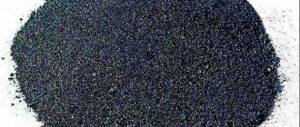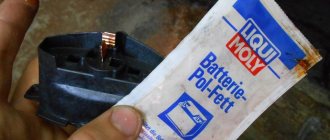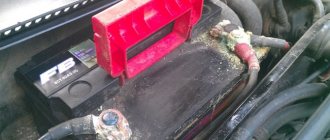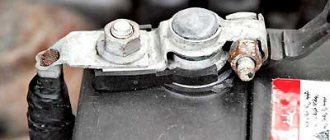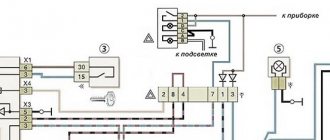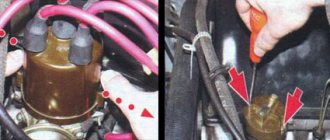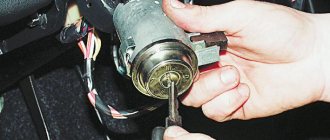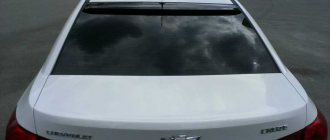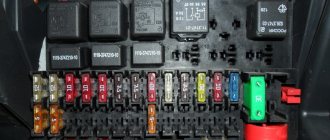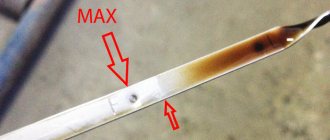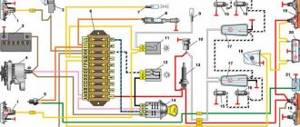Where is it used?
The main area of application for automotive contact lubricants is battery terminals. It is the electrical contacts of the battery that often become a problem area in car wiring. Considering that battery terminals are made of lead, and the contacts of power wires can be iron, aluminum or copper, these elements are especially actively oxidized.
Excessive oxidation leads to two main negative consequences.
- The contact patch between the terminal on the battery and the contact on the power wire is reduced. Due to the reduction in cross-section, this area begins to actively heat up. Local melting may occur.
- The battery loses its ability to supply electricity in the amount necessary for the normal operation of the starter and the vehicle’s electrical equipment in general. Sometimes this is mistakenly interpreted as wear and tear on the battery itself. And the car owner buys a new battery, although it was enough to simply clean and treat the contacts.
Electrical conductive lubricant is actively used by motorists when processing all detachable connections of car wiring. There are often cases when, due to a contact failure in the wiring of an electrical appliance, the car completely fails or its operational capabilities are seriously reduced. For example, if outdoor lighting fails at night due to oxidation of the wiring, it will make driving on public roads almost impossible (or extremely dangerous).
How to properly lubricate terminals
The protective properties of the lubricant are only provided when the electrical contacts in the protected connections are in good working order. If it is not there, then applying lubricant will not restore it.
When applying lubricant to the terminals, you need to understand that it is not necessary to apply it between the contact surfaces so as not to impair conductivity. Before connecting the terminals to the conductors, you need to ensure that the metal on the contacts is perfectly clean, even to the extent of treating them with a coarse cloth or fine sandpaper, wipe them with alcohol, and only then tighten them. After this, you need to apply a protective compound to the assembled connection and tighten it with the required force. If the lubricant is thick, you can apply it to the contacts with a rubber glove, and when using a spray, treat the protected surfaces from a spray can.
Operating principle and beneficial effect
Despite the fact that lubricants for electrical contacts from different manufacturers have different chemical compositions, their principle of action is approximately the same. The following are the main functions of lubricants:
- displacement of moisture;
- isolation from water and oxygen, which significantly reduces oxidative processes;
- protection against such phenomena as current leakage;
- reduction of contact resistance in the contact area of the terminals;
- penetration into oxide and sulfide deposits, which stops corrosion processes and liquefies deposits on the contact surface.
That is, after treatment with such a lubricant, oxidative processes in contacts slow down greatly or stop altogether. This significantly increases the reliability of car wiring and extends the service life of terminals and contacts.
What is the best way to lubricate battery terminals?
In Soviet times, special auto chemicals were practically not produced; to protect terminals from oxidation, drivers used grease, most often lithol. Various special products are now being produced to protect battery connections; the compositions perform several functions simultaneously:
- prevent the appearance of oxides;
- protect contacts from moisture and dirt;
- protect metal from corrosion.
To prevent the terminals from oxidizing, grease or technical petroleum jelly was also previously used among “folk” lubricants; all these compounds do not conduct electric current well, so their contact with electrical connections is unacceptable.
It is impossible to lubricate with lithol, as shown in the figure above, here we proceed as follows:
- Thoroughly clean the terminals and wire lugs at the connection points outside and inside;
- securely fasten the wires to the battery using bolts and nuts;
- Only after this do we apply lubricant on top.
Modern means of protecting terminals are various varnishes, aerosols, sprays, special petroleum jelly, and silicone grease is often used as a protective agent. Automotive chemicals are produced by many companies, the most popular brands in Russia are:
Often the protective agent colors the contact area in a bright red or blue color; this color allows you to clearly determine where the chemical composition is applied and whether the battery terminals still need to be treated. It should be noted that factory products are also dielectrics and do not improve electrical contact. They should also only be applied over connections to prevent poor starting and rapid battery drain.
Special auto chemicals are more reliable and more effective than lubricants such as litol or grease, these chemicals:
- have a dense structure;
- are poorly washed off with car shampoos and water during car washes;
- do not change their properties over time.
But many drivers are accustomed to using Litol-24, and even in the instructions for batteries the lubricant is recommended for use (for domestically produced batteries). It is convenient to apply the thick lubricant with a soft brush; it is necessary to add litol in several stages over the entire outer surface.
Liqui Moly lubricant and its analogues
Let's look at several popular lubricants used for automotive wiring contacts, starting with the most famous and suitable for this purpose.
- Liqui Moly. The manufacturer produces electrically conductive lubricants in two forms: aerosol (Electronic Spray) and gel (Batterie-Pol-Fett). Grease is more effective in the long term, as it is resistant to water washout and begins to drain spontaneously only after heating to 145 °C. However, using grease for hard-to-reach places is inconvenient, since it must be applied by contact. Aerosols are well suited for quickly treating contact surfaces, including hard-to-reach ones. But the effect of aerosols is short-lived. For effective protection, contacts will need to be treated at least once every 3 months.
- Solid oil or lithol. These are traditional lubricants for battery terminals and other car contacts. They are not entirely suitable for such purposes, since they do not provide sufficiently reliable protection against oxidation and dry out quite quickly. Requires frequent updating. Used mainly by old school drivers.
- Graphite lubricant. The main disadvantage of this oxidation protection agent is partial electrical conductivity and low spontaneous drainage temperature. Suitable for processing single contacts (battery, starter, generator). If small, multi-pin chips are lubricated, it can cause current leakage with accompanying malfunction of the electronics.
- Grease for protecting electrical contacts EFELE SG-383 Spray.
Contact lubricants are a good solution for those motorists who do not want to deal with the problems of wiring oxidation.
What to use for processing terminals
The range of lubricants for battery terminals is currently huge. They differ not only in the name of the manufacturer, but also in the composition, additives used, and additives.
This allows you to divide all mixtures into several categories. Each motorist will decide for himself what is best to lubricate the battery terminals.
Depending on the composition of the mixtures for treating car battery terminals, they can be divided into:
- silicone;
- Teflon;
- graphite;
- oil;
- copper;
- wax;
- consistent.
Now it’s worth separately considering all the presented options and understanding what should be used to lubricate the battery terminals, and what would not be the right solution for the car battery contacts.
Silicone
Modern silicone grease has only one drawback, which manifests itself in the form of fluidity. Otherwise, this is an excellent product that repels aggressive environments and is capable of operating in a temperature range from -60 to +180 degrees Celsius.
When choosing a spray or other silicone-based lubricant, make sure that the composition does not contain a conductive component. Even without it, silicone reduces resistance by about 30%.
Silicone requires quite frequent monitoring and processing. Make sure that liquid does not come into contact with the contacts. A thick layer on the surface should not be allowed to dry out, as this will greatly increase the resistance.
Teflon
Another popular composition for self-treatment of car battery terminals, which is based on Teflon. But the demand for it is not entirely clear.
Teflon lubricants have high penetrating properties. They are classified as liquid keys. But in the case of contact processing, completely different requirements are envisaged.
Teflon compounds are not recommended for treating battery contacts.
They are simply not suitable for such tasks.
Litol and solid oil
These products are from the category of oil lubricants. There is a lot of talk and debate about litol and solid oil. Some are sure that this is the best and most effective solution. Others categorically do not support the idea of using them for such purposes.
Both litol and solid oil are not conductive substances. But with temperature expansion of contacts and connections, these compounds begin to gradually penetrate between them. Over time, they can completely fill the cavities of the contact group. Also, due to temperature changes and natural wear, the characteristics of solid oil and lithol will change. They will harden, which will lead to poor quality of electrical contacts.
In the absence of other options, it is sometimes possible to use lithol and grease. But this is not the best solution. If there is no other choice, at least 2 times a year the lubricant must be completely cleaned and a new layer applied.
Consistent
Another option for lubricating the battery terminals under the hood of your car. In fact, these are special products created on the basis of synthetic or mineral oil. And sometimes by combining them. Thickeners, liquid and plastic components are added to the base.
Consistent materials can be used as a means for applying to terminals. Many of them directly indicate that they are intended for batteries.
Copper
For many, this is almost the best composition that performs its functions perfectly, and therefore is perfect for processing battery terminals.
Copper compositions are designed to work with elements that are subject to high dynamic, static and temperature loads. Copper substances have high viscosity, retain their properties for a long time, and do not allow the formation of oxides.
If you want to treat contacts efficiently, effectively and for a long time, feel free to take copper grease.
Graphite
Graphite lubricant raises much more questions regarding its use for the purposes under consideration.
One of the key features of graphite lubricants is their high resistivity. That is, the substance does not pass current through itself well and becomes very hot.
Because of this, the contacts may overheat, which will ultimately result in a fire. That is, graphite compounds are contraindicated in relation to the treatment of battery contacts.
Another argument against them is their small temperature range, which ranges from -20 to 70 degrees Celsius.
Wax
It’s quite a good and effective option that, due to its properties, allows you to process battery terminals.
Wax ensures the tightness of surfaces after treatment and has good dielectric properties. The application of such a composition prevents stray discharges from appearing. Plus, wax lubricants stay on the terminals for a long time.
Application area of the lubricant
EFELE electrical contact lubricant is universal, suitable for use in all types of electrical contacts: detachable, permanent, sliding and switching. It reliably protects battery terminals, relay contacts, sensors, plugs, sockets, electrical connector blocks, as well as high-voltage ignition wires.
The lubricant is used when installing contact connections operated by:
outdoors when exposed to climatic factors affecting the unit;
with fluctuations in temperature and air humidity;
in humid and maritime climates;
in underground rooms without heating and ventilation, including mines, basements, soil;
in rooms where water may stand for a long time or frequent condensation of moisture on surfaces.
How to properly apply lubricant to contacts?
Before using the lubricant, the contact surfaces must first be prepared: cleaned with a wire brush or sandpaper. Remove abrasive dust with a dry cloth, brush or other means.
The lubricant must be applied to the fully assembled and cleaned contact in an even layer with a thickness of 2 mm. If necessary, remove excess material with a soft cloth or lint-free rag.
Lubricant for electrical contacts is produced in a 210 ml aerosol metal can and in collapsible blister packaging. Durable plastic dispensers are easy to use and transport. Through an elongated flexible spout, the material can be easily applied to electrical contacts, even in hard-to-reach places where the use of other compounds is difficult. The lubricant is packaged in dispensers weighing 15 grams.
EFELE electrical contact lubricant reliably protects electrical components of cars and electrical appliances. The composition prevents moisture, chemically aggressive substances, and oxygen from entering electrical contacts. It prevents the formation of corrosion and oxides, significantly reducing the risk of failure and increasing equipment reliability.
Electrically conductive lubricant for automotive contacts. Our lineup rating!
Electrically conductive automotive contact lubricant is a necessary tool when preparing a vehicle for winter, as well as performing its regular maintenance.
Most often, the composition is used in the area of battery terminals, where problems are regularly observed. If we take into account that the terminals themselves are often made of lead, and the power cable contacts themselves are made of copper or aluminum, then you can understand why the parts are intensively oxidized and destroyed.
The formation of oxides provokes two extremely negative phenomena at once:
- The contact patch between the battery terminal and the wire contact itself becomes extremely small. The lack of contact area provokes overheating, which causes individual areas of the wire to melt, increasing the risk of fire.
- The battery cannot provide energy output in volumes that are sufficient for the correct functioning of the starter and other electrical modules of the vehicle. In some cases, drivers attribute this to battery wear, which is incorrect; it is a matter of poor contact. The driver buys a new battery, spending extra money, although the problem could be solved much simpler - it was necessary to clean the contacts.
Conductive contact grease is widely used by drivers to carry out complex processing of wiring elements connected by connectors. Quite often there are situations when a contact defect in the wiring of the device leads to the fact that the machine ceases to function correctly, or its capabilities are significantly reduced.
Very often, for example, the oxide destroys the contacts that supply power to the headlights. The running lights do not work, the trip becomes extremely dangerous, the visibility of the vehicle decreases, and the driver loses complete control over the road situation.
Why is lubrication necessary?
To improve electrical contact in a car, lubricant is needed not only to ensure full flow of current through the wires. In addition to this, it performs the following functions:
- removal of moisture from the contact area, lubricant is denser and heavier than water, due to which the liquid does not interact with metal elements;
- insulation from air, due to which oxidative processes occur less intensely;
- eliminating the possibility of the formation of “current leaks”;
- minimizing electrical resistance in the area where the terminal contacts the cable;
- penetration into deposits of sulfides and oxides already formed on the metal,
- neutralization of further corrosion, softening of deposits with the possibility of further removal.
Squad rating
Solid oil or a similar set of components, lithol, is very popular among motorists when processing contacts . Lubricants have been known since Soviet times, and therefore drivers of the “old school” sometimes simply do not see alternatives to them.
This is not entirely correct. Both compositions do not protect the metal from corrosion very well, they dry quickly, which is why they need regular updating.
The modern chemical industry offers much more technologically advanced alternatives:
1. Liqui Moly . The German brand offers drivers two lubrication options. The first is presented in the form of an aerosol, the second - in the form of a gel.
The gel is considered more durable , eliminates the need for frequent processing, since it withstands contact with water, is not washed off and acquires a fluid consistency only if the temperature of the environment rises to 145 degrees.
Unfortunately, treating hard-to-reach places with gel is an extremely difficult process; in such cases, an aerosol comes to the rescue. The main disadvantage of the aerosol is the need for regular treatment, which must be repeated every 2-3 months.
2. Graphite electrically conductive grease.
The best inexpensive option if you need to process single contacts, for example, battery terminals, generator or starter.
For miniature chips with several contacts, it is better not to use this composition; due to partial electrical conductivity, graphite can cause current leaks and, as a result, electronic failures.
3. Efele SG-383 . A modern development that combines versatility, durability and a high level of reliability.
This lubricant is excellent for any electrical equipment (including equipment operating under high voltage) and helps protect connections.
Motorists can use the composition to treat battery terminals and other connections in wiring; due to its significant thickness, the composition remains in place for a long time and retains its characteristics.
Watch a video about the advantages of lubricant for protecting electrical contacts Efele SG-383:
4. Copper grease consists of a binder and tiny particles of copper powder, available in gel and aerosol forms.
Copper is a metal with a high degree of electrical conductivity, so contact processing significantly improves contact characteristics.
This video explains how copper grease improves car starting:
Independent production
If it is not possible to purchase the composition in the store, a DIY gel may be the solution:
- As a binder base, you can use ED-5 grade epoxy resin (about 100 grams of the composition is required).
- The filler is silver powder (about 300 grams).
- Plasticizing additive – dibutyl phthalate (15 grams).
- Hardener – polyethylene polyamine (approximately 10 grams).
The hardener must be added to the composition immediately before application to prevent hardening.
Conclusion
Many drivers are also interested in the question: is it possible to lubricate contacts with silicone grease ?
In general, this is acceptable. Silicone displaces water, so it will protect the metal from oxidation and increase the life of contacts, but you need to keep in mind that specialized products, such as the products from Liqui Moly or other brands studied above, are much more effective.
For example, ordinary silicone grease is not capable of stopping corrosion that has already begun, unlike special agents that suppress the spread of oxides and neutralize them.
Watch an interesting video review of a new silicone lubricant for a car from the line of Russian auto chemical goods Autoprofi Performance:
Processing, cleaning, protecting and lubricating electrical contacts on video
Here is a video about processing and protecting contacts
Contact oxidation is one of the main enemies of electrical equipment. Approximately a fifth of all repairs to the electrical part of a car are in one way or another related to oxidation processes.
—>
—>
That's why many drivers often wonder how to clean oxidized contacts in a car.
—>
—>
